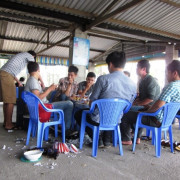Английского языка для программы work and study в канаде
Содержание:
- Особенности программы Work and Study в Канаде
- List of ROs
- Где искать работу в Канаде в 2021 году
- Практика и работа
- Definitions
- Get the instructions
- Apply online from outside Canada
- Apply on paper from outside Canada
- Почему это один из лучших вариантов
- Who can work off campus
- Apply online from inside Canada
- Ne Kadar Kazanabilirim?
- Can I Stay in Canada After I Graduate?
- Guidelines
- Working after you complete your study program
- Kanada Work and Travel Vizesi Başvuru Tarihleri ve Şartları
- Apply on paper from outside Canada
- Зарплатные перспективы
- Regularly scheduled breaks
- Canadim’s International Student Program
- Working while we process your application
- Scholarship value and duration
- Eligibility
Особенности программы Work and Study в Канаде
- +7 800 775-09-75 Россия
- +7 499 753-22-00 Москва www
- +7 343 300-92-21 Екатеринбург www
- +7 351 700-11-10 Челябинск www
- +7 395 279-97-39 Иркутск www
- +7 341 220-88-08 Ижевск www
- +7 861 202-95-55 Краснодар www
- +7 861 779-34-69 Новороссийск www
- +7 863 333-41-00 Ростов-на-Дону www
- +7 3012 20-42-09 Улан-Удэ www
- +7 842 279-22-82 Ульяновск www
- +7 347 258-88-22 Уфа www
- +7 717 269-63-55 Нур-Султан (Астана)
- +7 908 080-46-60 WhatsApp
Work and Study в Канаде
Work and Study Canada — уникальная в своём роде программа, так как, оставаясь доступной, она удовлетворяет многим потребностям и является первой ступенькой для достижения различных целей. Как нетрудно догадаться из названия, программа состоит из двух основных элементов — учёба и работа. Хочешь выучить английский язык или довести его до совершенства? Языковая часть обучения поможет тебе в этом. Обучение происходит на базе одного из канадских колледжей и включает в себя профессиональное образование в сфере гостиничного менеджмента. При желании, или необходимости, можно взять дополнительный курс английского языка, который позволить быстрее влиться в англоязычную среду или поступить в зарубежный вуз. Продолжительность программы позволит тебе освоиться в Канаде, и, если эта страна придётся тебе по нраву, лично посетить вузы и выбрать для себя подходящий. Если ты любишь путешествовать, стремишься зарабатывать, хочешь получить новый опыт — эта программа также подойдёт для тебя. Население самого города — 631 486 человек
| Возраст 18-26 лет | Даты программы Круглогодично | ||
| Иностранный язык Английский | Уровень языка Intermediate (В1) и выше | ||
| Требования Языковой уровень, возраст | Срок оформления 3 месяца | ||
| Продолжительность от 24 недель |
Дополнительные услуги по сопровождению (не входят в стоимость языкового курса):
Work and Study (Обязательный пакет услуг) от 40000₽
| Подбор, регистрация и ознакомления с программой | Медицинская страховка для визы |
| Корреспонденция с учебным-языковым центром | Оплата базового пакета программы Work and Sturdy |
| Перевод документов на английский язык | Предвыездная ориентация |
| Нотариальное заверение документов для посольства | Заполнение визовых анкет для выезда |
| Оформление визы | Курьерские и почтовые услуги |
В стоимость базового пакета услуг не входит
List of ROs
AIESEC Canada
AIESEC Canada is a non-profit organization that helps develop leadership in youth.
Types of work permits:
Young Professionals (employer-specific work permit) for career development
Target market: Youth aged 18 to 30
Eligible to: IEC countries/territories, Brazil, India
GO International
GO International is a Canadian organization that offers work and travel opportunities.
Types of work permits:
Working Holiday (open work permit)
Target market: Youth aged 18 to 35
Eligible to: IEC countries/territories, the United States
International Association for the Exchange of Students for Technical Experience (IAESTE)
IAESTE offers opportunities in technical career-related jobs.
Types of work permits:
- Young Professionals (employer-specific work permit) for career development
- International Co-op (Internship) (employer-specific work permit) for students
Target market: Youth aged 18 to 35
Eligible to: IEC countries and other IAESTE country partners
A-Way to Work/International Rural Exchange Canada Inc.
Through A-Way to Work, the non-profit International Rural Exchange Canada offers paid opportunities to young people in
- agriculture
- hospitality
- culinary arts
- tourism
- horticulture
- landscaping
- other sectors.
Types of work permits:
- Working Holiday (open work permit)
- Young Professionals (employer-specific work permit) for career development
Target Market: Youth aged 18 to 35
Eligible to: IEC countries/territories only
Memorial University of Newfoundland (MUN)
Memorial University offers internships for students and recent graduates.
Types of work permits:
- Working Holiday (open work permit)
- International Co-op (Internship) (employer-specific work permit) for students
Target market: Youth aged 18 to 35
Eligible to: IEC countries/territories only
Stepwest
Stepwest offers work experiences ranging from paid ski resort jobs to industry-specific student internships.
Types of work permits:
- Working Holiday (open work permit)
- Young Professionals (employer-specific work permit) for career development
Target market: Youth aged 18 to 35
Eligible to: IEC countries/territories only
SWAP Working Holidays
SWAP Working Holidays helps with working holidays and young professional work and travel opportunities.
Types of work permits:
- Working Holiday (open work permit)
- Young Professionals (employer-specific work permit) for career development
Target market: Youth aged 18 to 35
Где искать работу в Канаде в 2021 году

Сайты для поиска работы в Канаде онлайн
Самое популярное и, пожалуй, эффективное в наше время место поиска работы и вакансий в Канаде в 2021 году — это интернет. В Канаде существует множество площадок, на которых ежедневно постится множество позиций. Вот самые популярные из них:
- Indeed
- Craigslist (особенно популярен у жителей Ванкувера)
- Kijiji
- MonsteR
- Job Bank
- Workopolis
- Work BC
На каждом из этих сайтов вы найдете множество легитимных рабочих вакансий в Канаде. К слову, JobBank — это правительственная площадка и чаще всего именно через нее иммигранты имеют самые реальные шансы быть нанятыми. Для каждой отдельной позиции крайне рекомендуется подредактировать ваше резюме таким образом, чтобы оно максимально соответствовало позиции. Что касается резюме, то рекомендуем пройтись по нашей статье «Резюме в Канаде: правила и техники написания (с примером)».
Нетворкинг как способ поиска работы в Канаде

Бывает, что иммигранты сталкиваются проблемами трудоустройства в Канаде. Например, работодатель может сомневаться, нанимать ли иммигранта, который недавно приехал в Канаду, даже несмотря на его внушительный опыт работы в родной стране. В таком случае вам на помощь приходит нетворкинг. Что такое такое нетворкинг и как его использовать в Канаде? Нетворкинг — это деятельность, направленная на то, чтобы с помощью людей, в вашем кругу общения, максимально быстро решать не только жизненные потребности (найти работу), но и бизнес задачи (найти клиентов, привлечь инвесторов и т.д.). Как искать правильный круг общения? Ниже приведены некоторые советы по поводу нетворкинга в Канаде.
Вступите в профессиональное объединение
Присоединитесь к какой-нибудь профессиональной организации по вашей специальности. Так вы познакомитесь с коллегами и влиятельными людьми, что может ускорить поиски работы. Подобного рода организации вы можете найти не только на популярных соц. сетях как Facebook или LinkedIn, но также на сайте , либо скачать популярное мобильное приложение Shapr. Кто знает, можете именно они предложат вам вакансию мечты?
Волонтёрская работа
Этот совет может казаться противоречивым, но чем больше вы будете работать волонтёром, тем быстрее найдёте постоянную работу по профессии в Канаде
Будучи волонтёром, вы расширяете круг знакомств, пополняете резюме опытом работы в Канаде и просто улучшаете себе карму, потому что канадские работодатели обращают особое внимание на волонтёрский опыт. В конце концов, чем больше вы отдаёте, тем больше получаете
В 2021 году, более 1 млн. канадцев уже были задействованы в волонтерской деятельности!
Цель – не просто найти работу
Важно помнить, что главная цель – найти «своих» людей, а не просто связи. Люди, с которыми вы познакомитесь сразу по приезду, а это всегда очень тяжёлый период, могут стать вашими хорошими друзьями, которые поддержат вас и помогут устроиться в новой стране
И, возможно, как приятное дополнение, ваши новые друзья вспомнят о вас, когда услышат, что кто-то ищет сотрудника в свою фирму.
Рабочие агентства в Канаде

Рабочие агенства — еще один неплохой вариант для поиска работы в Канаде. Этот вариант больше подходит студентам, кто ищет низкоквалифицированную работу, и не хочет заморачиваться с поиском и тратить время. Такие агентства все сделают за вас, все что нужно, это отнести свое резюме (которое вам помогут грамотно отредактировать, или же вообще составить новое с нуля) и ждать звонка.
Эти агентства сотрудничают со множеством работодателей и подберут вам работу в кратчайшие сроки. Большой плюс таких услуг, что вы не тратите ни время ни деньги при поиске работы, агентства предоставляют подобного рода услуги «бесплатно» (скорее всего комиссию за вас будет платить работодатель или же часть вашей зарплаты будет идти на счет агентства).
Рабочих агенств в Канаде полно. Просто загуглите recruitment agency in Canada, и сможете изучить множество вариантов.
Что касается рабочих агенств, которые могут помочь устроиться если вы не живете в Канаде, то об этом поговорим ниже.
Практика и работа
В рамках программы я год учился по обмену в Швейцарии в ETH Zürich – это ведущий технический университет, из которого вышло 32 нобелевских лауреата. Еще там преподавал Альберт Эйнштейн. Предметы тут посложнее, но во время семестра было намного легче, потому что домашние работы либо отсутствовали, либо отнимали мало времени.
Все обучение стоило $500, что по сравнению с вузами в Америке можно назвать почти бесплатным. В Америке только одни учебники обойдутся в такую сумму. Но в Европе университеты меньше решают вопросы быта. Например, UBC помогает с жильем, бесплатно предоставляет комнаты для кружков, курирует кафе и рестораны по всему кампусу и т.д.
Кремниевой долине
Калифорния. Ануар – второй справа. Конференция по компьютерному зрению, 2019 год
Definitions
-
Academic program: A post-secondary program that awards academic credentials to persons for whom the normal entrance requirement is high school completion or higher. This program is often delivered at institutions that award an academic degree, diploma or certificate, such as any of the following:
- universities
- colleges
- CEGEPs
- seminaries
- institutes of technology
- Professional training: A type of training usually offered to a person who is already a professional in a given field. Professional development is generally “accredited”; that is, it is recognized by an industry, association or profession. Professional training can be offered by learning institutions or professional associations, regulatory bodies or unions (for example, real estate appraisal, production and inventory control, food services management or specialty courses for lawyers, doctors, accountants, business administrators, engineers, dentists, teachers and counsellors).
-
Vocational training: A preparation for a specific occupation in an industry or a trade that is generally “accredited”. It may be offered through on-the-job programs, by unions in conjunction with businesses or employers or by learning institutions in conjunction with a specific industry or employer. This training may include any of the following:
- technical training
- organizational training
- basic skills training
- Regularly scheduled break: To be considered a regularly scheduled break, the break must be part of the DLI’s academic calendar (for instance, winter and summer holidays, Reading Week). Each regularly scheduled break should not be longer than 150 days. The maximum cumulative duration of scheduled breaks is 180 days per calendar year.
- Off campus: Any location outside the boundaries of the campus of the educational institution at which the student is registered.
Get the instructions
Answer a few questions to get your instructions.
You need to enable Javascript to be able to use the tool.
Apply online from outside Canada
To apply online, you’ll need:
- a scanner or camera to create electronic copies of your documents, and
- a valid or card.
Step 2: Read the instruction guide
Even if you apply online, you should read the instruction guide before you complete your application. The guide will explain how to complete each field on the form.
Step 3: Prepare your answers for the online tool
Before you can upload your forms, you must answer some questions. We use your answers to create a personalized document checklist for you.
Step 4: Know the fees you have to pay
In most cases, your fees will include:
- processing fees for you and anyone you include on your application
- biometrics
We’ll ask you to pay your fees at the end of your application. Make sure you pay both the open work permit holder fee and the work permit fee.
Third-party fees
Depending on your situation, you may need to pay third parties for:
- medical exams
- police certificates
- services at a Visa Application Centre, if you use one.
If you need to use any of these services, you’ll pay these fees directly to the third party.
Biometrics fee
In most cases, you should pay a biometrics fee when you submit your application. Otherwise you may experience delays. The biometrics fee covers the cost of collecting fingerprints and a digital photo. Find out if you need to give your biometrics.
Step 5: Create your online account or sign in
You need an account to apply online. You can use your account to:
- pay your fees
- submit your application
- check your status
Create an account or sign in
Apply on paper from outside Canada
Step 1: Get the application package
The application package includes an instruction guide and all the forms you need.
Read the instruction guide before you complete your application. We won’t refund your application fee, so make sure you’re eligible for a PGWP before you apply.
Step 2: Complete your application and attach your documents
Make sure you include all the documents we ask for. Your application may be delayed if information or documents are missing. The document checklist in the application package lists all the documents to include.
Answer all questions carefully, completely and truthfully.
Third-party fees
Depending on your situation, you may need to pay third parties for:
- medical exams
- police certificates
- language testing
- services at a Visa Application Centre, if you use one.
If you need to use any of these services, you’ll pay these fees directly to the third party.
Step 3: Pay your applications fees
In most cases, your fees will include:
- processing fees for you and anyone you include on your application
- biometrics
You’ll need to pay your fees online before you submit your application. Make sure you pay both the open work permit holder fee and the work permit fee. To do this:
- Go to pay your fees online.
- Select Temporary Residence for a list of fee options.
- Select both the work permit fee and the open work permit holder fee.
- Follow the instructions to complete your payment. Save a copy of your receipt to your computer.
- Print and attach a copy of your receipt to your completed application.
Our can help you understand which fees apply to you and show you how to pay them.
Biometrics fee
In most cases, you should pay a biometrics fee when you pay your application fees. If you don’t, you may experience delays. The biometrics fee covers the cost of collecting fingerprints and a digital photo. Find out if you need to give your biometrics.
Submit your completed application to the address given in the application package. Make sure you include the fee receipt and all the necessary documents.
Почему это один из лучших вариантов
Наш бестселлер — PDF-книга о стоимости переезда в Канаду: начиная от перевода документов, до перевозки животных в Канаду и аренды квартиры.
Что я могу сказать по этому поводу? Вариант абсолютно реальный, более того я склоняю шляпу перед человеком, который это предлагает, и который об этом думает, потому что большинство иммигрантов, когда приезжают сюда, все-таки стараются вернуться к своему профессиональному полю деятельности, к своему статусу социальному, и люди идут по пути набивания своих собственных ошибок первое время, пытаясь найти работу аналогичную той, которая была дома.
Это продолжается, как правило, до тех пор, пока люди не проедают те деньги, которые привезли с собой со страны исхода, и только потом жизнь заставляет их пересмотреть подход и пытаться в судорожной манере, либо пытаться переучиться на какую-то рабочую специальность, либо бросаться за любую работу для того, чтобы прокормить себя и, естественно, свою семью.
Who can work off campus
You and your employer must make sure you can work off campus without a work permit before you start working. If you start working off campus but don’t meet the requirements, you may have to leave Canada.
You can only start working in Canada when your study program has started. You can’t work before you start your studies.
If you’re able to work during your studies, it’ll say so in the conditions on your study permit.
Eligibility requirements
You can work off campus without a work permit if you meet all of these requirements:
- you’re a full-time student at a designated learning institution (DLI)
- you’re enrolled in
- a post-secondary , or program or
- a secondary-level vocational training program (Quebec only)
- your study program
- is at least 6 months long and
- leads to a degree, diploma or certificate
- you’ve started studying
- you have a Social Insurance Number (SIN)
If you’re a part-time student
You can work off campus only if:
- you meet all of the requirements above and
- you’re only studying part-time, instead of full-time, because:
- you’re in the last semester of your study program and you don’t need a full course load to complete your program and
- you were a full-time student in your program in Canada, up until your last semester
If you’re on an , or you’re switching schools and you’re not studying, you can’t work off campus. You can only return to work once you’re back to studying.
Get a Social Insurance Number to work in Canada
A SIN is a 9 digit number that the Government of Canada gives you. You need one to work in Canada.
To apply for a SIN to work off campus, you must have 1 of these conditions printed on your study permit:
- May work 20 hours per week off campus or full-time during regular breaks if meeting criteria outlined in paragraph 186(v) of the Immigration and Refugee Protection Regulations.
- May accept employment on or off campus if meeting eligibility criteria, per paragraph R186(f), (v) or (w) and must cease working if no longer meeting these criteria.
If your study permit doesn’t have work conditions on it
You can ask to have these conditions added if you’re eligible to work off campus. There’s no fee to add these conditions to your permit.
You’ll need to request an amendment to your study permit before you can apply for a SIN from Service Canada.
How many hours you can work off campus
During scheduled breaks in the school year
You can work full-time if you’re on a scheduled break, such as winter and summer holidays, or a fall or spring reading week. You’re free to work overtime or work 2 part-time jobs that add up to a higher than usual number of hours.
You must be a full-time student both before and after the break to work full-time.
You can’t work during a break that comes before you start your very first school semester.
How many hours count as full-time work
There is no set number of hours per week that counts as ‘full-time’ work. However, your employer(s) must follow all provincial laws on overtime pay and time between shifts.
If your program doesn’t have scheduled breaks
Working more than 20 hours per week is a violation of your study permit conditions. You can lose your student status for doing this, and may not be approved for a study or work permit in the future. You may also have to leave the country.
Apply online from inside Canada
To apply online, you’ll need:
- a scanner or camera to create electronic copies of your documents, and
- a valid or card.
Step 2: Read the instruction guide
Even if you apply online, you should read
the instruction guide before you complete your application. The guide will explain how to
complete each field on the form.
Step 3: Prepare your answers for the online tool
Before you can upload your forms, you must answer some questions. We use your answers to create a personalized
document checklist for you.
Step 4: Know the fees you have to pay
In most cases, your fees will include processing fees for you and anyone you include on your application.
We’ll ask you to pay your fees at the end of your application.
COVID-19: Changes to biometrics requirement for in-Canada temporary residence applicants
As a temporary measure, if you’re in Canada and applying to work, study or stay temporarily in Canada, you do not
need to give your biometrics. .
Step 5: Create your online account or sign in
You need an account to apply online. You can use your account to:
- pay your fees
- submit your application
- check your status
Create an account or sign in
If you can’t apply online
You can submit a paper application if either:
- you can’t apply online because of a disability
- there’s a problem with the online
application
Ne Kadar Kazanabilirim?
Kanada Hükümeti’nin öğrencilere çalışma hakkı sunmasının nedeni, masraflarını karşılayabilecek kadar para kazanmalarında destek olmaktır. Bu nedenle çalışma saatleriniz, yaşam masraflarınızı minimum düzeyde karşılayabileceğiniz şekilde ayarlanmıştır.
Kazanabileceğiniz saatlik ücretler, bulunduğunuz eyalete göre değişiklik göstermektedir. Toronto gibi gelişmiş şehirlerin bulunduğu ve yaşam masrafları daha fazla olan Ontario Eyaleti’nde saatlik ücret asgari 14,25 Kanada Doları’dır. Yaşam masrafları daha az olan Manitoba Eyaleti’nde ise saatlik ücret asgari 11,95 Kanada Doları’dır.
Her sene güncellenen bilgilere ulaşmak için tıklayın.

Can I Stay in Canada After I Graduate?
Canada makes it easy for international students to become permanent residents if they want to remain in the country.
The Post-Graduate Work Permit allows international students to stay in Canada and work for up to three years after graduating. After working in Canada for one year, international graduates may be eligible to apply for permanent residency.
To apply for a PGWP, you need to prove that you have respected all the conditions of your study permit. Studying must have been your primary activity during your time in Canada.
A PGWP is typically granted for the same duration as your studies in Canada.
Guidelines
The Study in Canada Scholarships program is facilitated through institutional collaborations and student exchange agreements between post-secondary institutions in Canada and in the following eligible countries/territories: Algeria, Bangladesh, Burkina Faso, Egypt, Ethiopia, Ghana, Ivory Coast, Jordan, Kenya, Libya, Morocco, Nepal, Nigeria, Rwanda, Senegal, Taiwan, Tanzania, Tunisia, Turkey, Uganda, and Ukraine. These agreements are created between colleges, technical or vocational institutes and universities. Students, hereby referred to as «candidates», must be registered as full-time students in their home institution at the time of application and during the entire duration of their study or research stay in Canada.
Working after you complete your study program
After you complete your study program, there are 2 ways you may be able to work full-time:
- you already applied for a work permit before your study permit expired or
- you’re starting a new study program
You need to meet all the requirements listed below to work full-time. If we refuse your work or study permit application, you must stop working and leave Canada.
If you already applied for a work permit
- You were already able to work off campus during your studies
- You applied for a work permit or post-graduation work permit (PGWP) before your study permit expired
- You’re waiting for a decision on your work permit application
Kanada Work and Travel Vizesi Başvuru Tarihleri ve Şartları
Peki, Kanada Work and Travel Vizesi başvuru tarihleri ve şartları nelerdir? 30’dan fazla katıldığı programa katılabilmek için öncelikle katılımcının vatandaşı olduğu ülke ile Kanada hükümetinin bir çalışma izni anlaşması bulunmalıdır. Türkiye’nin böyle bir anlaşması olmadığı için Kanada Work and Travel programına Türkiye’den başvuru yapmak mümkün değildir.
Kanada Work and Travel programına katılabilmenin diğer bir şartı ise katılımcının istenilen yaş aralığında olmasıdır. Katılımcıların yaş aralığı genellikle 18 ile 35 arasında değişkenlik gösterse de kimi ülkelerde 29 veya 30 yaş sınır olabilmektedir.
Uluslararası Kanada Deneyimi programına bağlı olarak başvuru yapılabilen iki çalışma izni bulunmaktadır: açık çalışma izni ve işverene özel çalışma izni. Çalışarak Tatil kategorisi açık çalışma izni sağlamaktadır. Bu çalışma izin ile başvuru sahipleri diledikleri işverenle ve birden fazla lokasyonda çalışma hakkına sahiptir. Aynı zamanda bu vize sayesinde Çalışarak Tatil programı katılımcılarının önceden hazırlanmış bir iş teklifine ihtiyacı yoktur. İşverene özel çalışma izni ise Genç Profesyoneller ve Uluslararası Maaşlı Staj kategorilerini kapsamaktadır. İşverene özel çalışma izni alacak kişilerin; birlikte çalışacakları işveren, ne kadar süre ve nerede çalışacakları aynı zamanda hangi iş kolunda çalışacağı önceden belirlidir.
Kanada Work and Travel başvuru sahiplerinin hazırlaması gereken çeşitli evraklar bulunmaktadır. Öncelikle tüm adayların pasaport, doğum belgesi, adli sicil kaydı, sağlık raporu ve fotoğraf hazırlaması gerekmektedir. Daha sonra katılımcıların ülkeye vardıklarında masraflarını karşılayabileceğini gösteren finansal evraklar olmalıdır. Diğer bir zorunlu evrak ise sağlık sigortasıdır. Aynı zamanda işverene özel çalışma iznine başvuracak kişiler için iş sözleşmesi olmalıdır.
Ülkeden ülkeye göre değişkenlik gösterse de genel olarak benzer başvuru aşamaları bulunmaktadır. Öncelikle tüm başvuru sahipleri başvuru formunu doldurmalıdır. Daha sonra varsa başvuru ücretlerini ödemelidir. Son aşamada ise gerekli evraklar yüklenmeli ve başvuru tamamlanmaktadır.
Apply on paper from outside Canada
Step 1: Get the application package
The application package includes an instruction
guide and all the forms you need.
Read the guide carefully before you complete your application. We won’t refund your application
fee, so make sure you’re eligible for a study permit before you apply.
Step 2: Complete your application and attach your documents
Make sure you include all the documents we ask for. Your application may be delayed if information or documents are
missing. The document checklist in the application package lists all the documents to include.
Answer all questions carefully, completely and truthfully.
Зарплатные перспективы
Дальше уже, после окончания учебы, после того, как вы начнете работать, зарабатывать, у вас появится понимание того, стоит ли вам получать другое образование более высокого уровня, не стоит и так далее. Это уже up to you – это исключительно от вас зависит. И что касается последнего момента, заработная плата рабочие обычно стартуют, с DEP-ом, которые нормально отучились, от 13-15 долларов за час работы. Соответственно, если какая-то там мегаопасная профессия, те же самые крановщики, как человек меня спрашивает, в том числе про крановщиков. Крановщики наверняка будут получать, начиная от 20-25 долларов, потому что это работа, сопряженная с риском.
И еще раз говорю, что, в отличие от офисных работ, рабочие руки всегда требуются на рынке труда, и вы никогда не будете сидеть долго без работы, вы всегда будете востребованы. Поэтому для тех людей, для которых вопрос с финансовыми резервами стоит очень жестко, и вы планируете очень-очень ваш бюджет, вы понимаете, что вы долго на том, что вы привезли из дома, не протянете, не проживете, этот вариант с получением рабочей специальности прекрасный, изумительный вариант, и я вам его рекомендую.
На этом я прощаюсь, желаю всего хорошего, до свидания!

Языковые курсы и колледжи в Канаде: новые возможности для студентов
Хотите иммигрировать в Канаду, но не знаете с чего начать?
Пройдите бесплатную оценку шансов с помощью искусственного интеллекта, который проанализирует все доступные способы и скажет стоит ли вам тратить время.
Regularly scheduled breaks
In order to work off campus without a work permit under paragraph R186(v), students must hold full-time status during the academic session before and after their regularly scheduled break. See the regularly scheduled break section under .
Maximum duration of a regularly scheduled break
If an institution allows for back-to-back scheduled breaks, thus creating a break period longer than 150 consecutive days, students are only eligible to work off campus during the first 150 consecutive days. They cannot work for the entire break if it is longer than 150 consecutive days.
Taking into account all regularly scheduled breaks, students may only work off campus on a full-time basis for a total of 180 days during each calendar year.
Full-time or part-time course load during a regularly scheduled break
Students who are enrolled full time during the academic sessions before and after a regularly scheduled break and who decide to undertake a full-time or part-time course load during that regularly scheduled break are eligible to work off campus on a full-time basis. If a program of study does not provide for a regularly scheduled break and a student creates their own break in a program, it is considered a leave from studies, rather than a regularly scheduled break. Students who create their own break in a program are not eligible to work on or off campus during that break.
Labour actions
International students who are unable to fulfil their conditions as temporary residents due to circumstances entirely beyond their control (for instance, a school strike) during a regular academic session can, if they are eligible, still only work part time (up to 20 hours a week) off campus. In the event that a DLI goes on strike during a regularly scheduled break, international students who are eligible to work off campus may work full time only during the period that constitutes the regularly scheduled break.
Canadim’s International Student Program
Canadim’s International Student Program can help to guide you through the process. From getting your study permit to permanent residency, we’ll be there every step of the way. With our help, you can transform a Canadian education into Canadian permanent residence.
Every one of our International Student Program clients is paired with an Educational Counsellor who has been trained in the landscape of Canadian higher education and immigration in Canada. With their help, you will submit the strongest possible application.
Here are the basic steps of the application process:
1. Choose a Program: Your program choice is one of the most important factors of your study permit application. You must present a strong case for studying in Canada in this particular program. We make program recommendations based on your work experience and education history. This will give you the best possible chance of submitting a successful application.
2. Apply to the School: After deciding on a program, we will help you prepare and submit your application. You need to have a letter of acceptance from a Canadian designated learning institution (DLI) before you can apply for a study permit.
3. Apply for a Study Permit: With your acceptance letter in hand, you’ll be ready to apply for your study permit. We will help you to prepare and submit your application to Canadian immigration.
Working while we process your application
You can work full-time until we make a decision on your work permit application if you
- had a valid study permit when you submitted your application
- completed your study program
- were eligible to work off campus without a work permit while studying and you didn’t work more hours than you were allowed to
If these conditions apply to you and you need to prove to an employer that you’re eligible to work, provide the employer with a copy of all the required documents.
If these conditions don’t apply to you, you must wait until your work permit arrives to begin your new job. It’s illegal to work in Canada without authorization.
If we refuse your work permit, you must stop working the day we notify you.
Scholarship value and duration
Funding for Study in Canada Scholarships is made available by Global Affairs Canada through its legal title: the Department of Foreign Affairs, Trade and Development (DFATD).
The Canadian institution will receive funding from DFATD for all successful candidates in the form of a contribution agreement and will be responsible for providing the funds to scholarship recipients.
The scholarship value varies depending on the duration of studies:
- CAD 10,200 for college, undergraduate or graduate students (Master’s and PhD) for a minimum of four months or one academic term of study or research; or
- CAD 12,700 for graduate students (Master’s and PhD) for a period of five to six months of study or research.
In addition to the funds allocated to the recipients by DFATD, the Canadian host institution may also claim CAD 500 per scholarship recipient to assist with administrative costs once the scholarship recipient arrives in Canada.
Eligible expenses
Canadian institutions will disburse scholarship funds to the scholarship recipient to contribute to the following costs:
- visa or study/work permit fees;
- airfare, for the scholarship recipient only, to travel to Canada by the most direct and economical route and return airfare upon completion of the scholarship;
- health insurance;
- living expenses, such as accommodation, utilities and food;
- ground public transportation, including a public transportation pass; and
- books and supplies required for the recipient’s study or research, excluding computers and other equipment.
Payment procedure
Subject to the terms and conditions of the Contribution Agreement, funding will be disbursed by a cheque or Electronic Funds Transfer (EFT) issued to the Canadian institution upon receiving the following documents:
- the Contribution Agreement signed by both the designated authority at the Canadian institution and the designated authority at DFATD; and
- a Cash Flow Statement submitted by the Canadian institution to coincide with the arrival of the scholarship recipients in Canada.
Funds will be disbursed to the scholarship recipients according to the Canadian institution’s internal processes and in conformity with the Contribution Agreement concluded between DFATD and the Canadian institution. Canadian institutions will typically disburse funds to scholarship recipients in instalments.
The Canadian institution will retain proof of scholarship payments to the recipient(s) and other documents required as further outlined in the Contribution Agreement concluded between DFATD and the Canadian institution.
Eligibility
Candidates must be citizens of one of the following eligible countries/territories:
- Asia: Bangladesh, Nepal, Taiwan
- Europe: Turkey, Ukraine
- Middle East and North Africa: Algeria, Egypt, Jordan, Libya, Morocco, Tunisia
- Sub-Saharan Africa: Burkina Faso, Ethiopia, Ghana, Ivory Coast, Kenya, Nigeria, Rwanda, Senegal, Tanzania, Uganda
Candidates:
- must be enrolled as full-time students at post-secondary institutions in the eligible countries/territories and paying any tuition fees required by these institutions at the time of application and for the full duration of the exchange;
- who hold Canadian citizenship or permanent residency, or who have a pending application for permanent residency in Canada are not eligible;
- already participating in an exchange scholarship program funded by the Government of Canada are not eligible; and
- already enrolled in a program at a Canadian post-secondary institution are not eligible.








